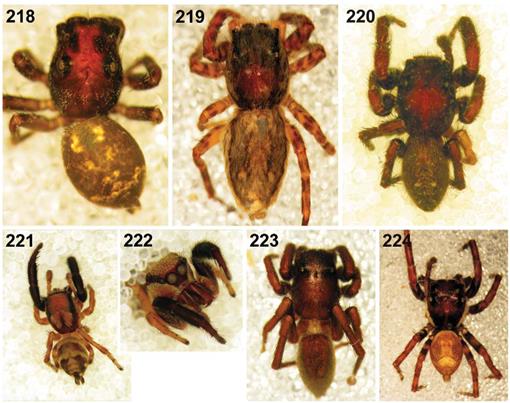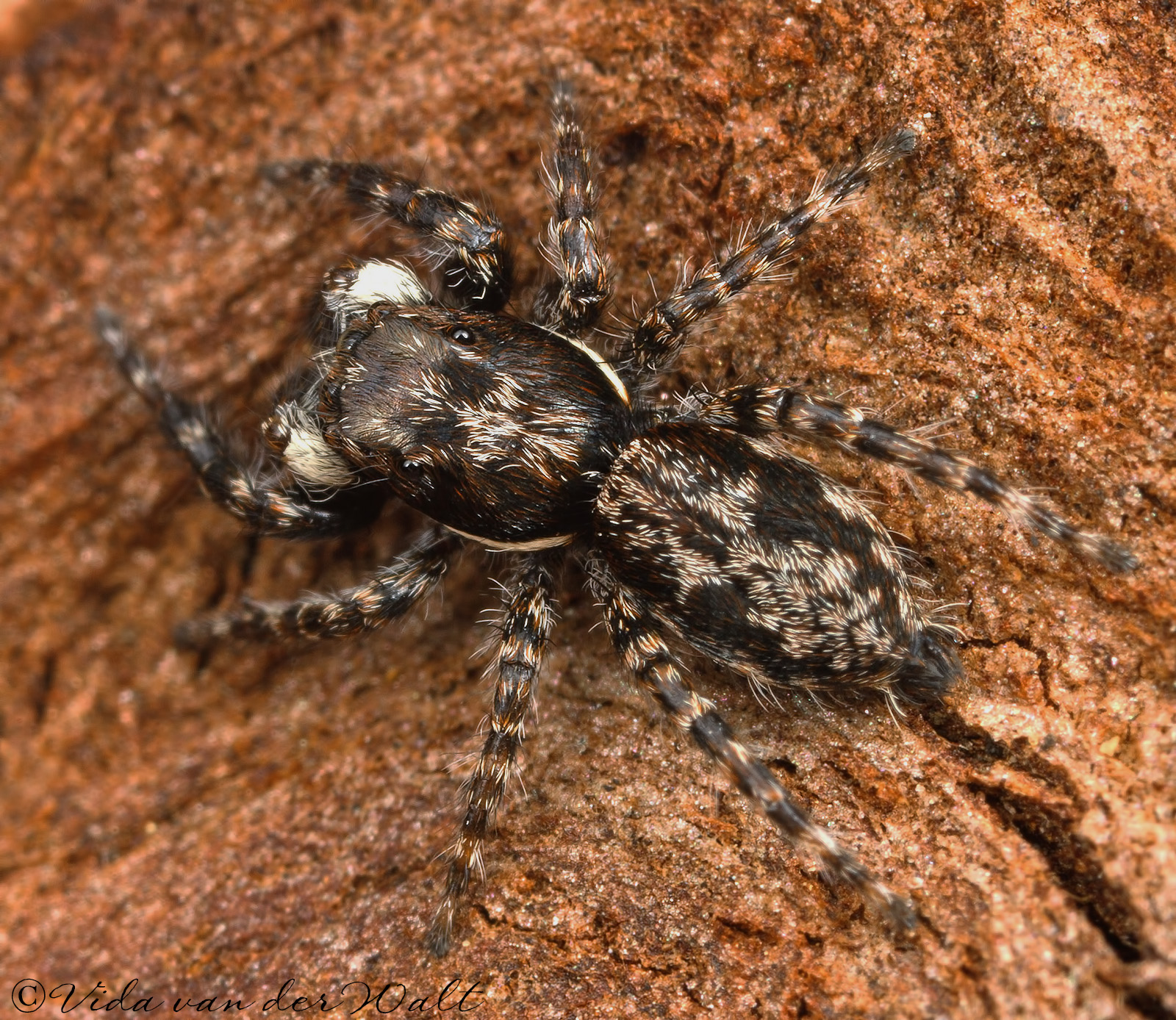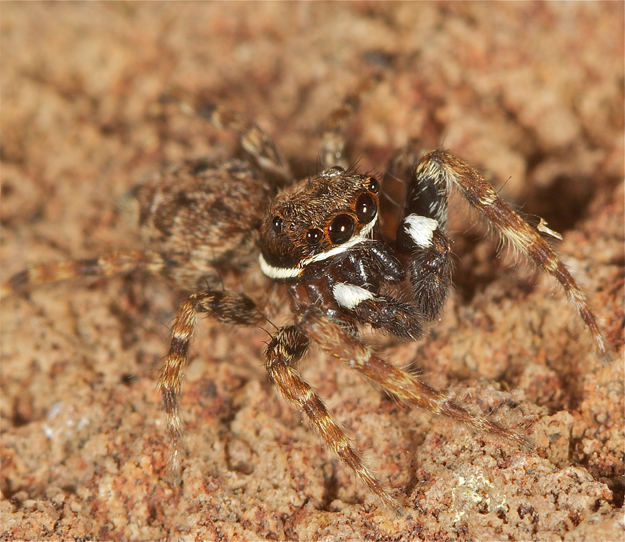Menemerus
Wesołowska, W. (1999). A revision of the spider genus Menemerus in Africa (Araneae: Salticidae)
http://citeseerx.ist.psu.edu/viewdoc/do ... 1&type=pdf
The genus is quite characteristic, but morphologically rather uniform, therefore it is easy to distinguish it from other genera, but species identification within the genus is fairly difficult.
DIAGNOSIS
Medium to big spiders, ranging from about 4 to 10 mm in length; body flattened, strongly hairy. Carapace in the majority of species with white lateral margins.
This fits!DESCRIPTION
Cephalothorax rather low, flat and broad, broadest behind half of its length.
Carapace brown, eye field darker, in some species foveal area lighter, yellowish. Whole carapace clothed in short, dense, brown and greyish-white hairs. Near eyes numerous brown, long bristles. In majority of species along lateral margins of carapace extends a stripe composed of white hairs. Arrangement and size of eyes typical for the family. Eye field rectangular or slightly trapezoid, wider than long. Clypeus low, usually brown.
Chelicerae dark brown, with two teeth on promargin and single tooth on retromargin.
Abdomen oval, in some species elongate, in others rounded. Coloration of abdomen varies, frequently dark with leaf-shaped lighter pattern or with pattern composed of numerous light patches. Abdomen clothed in very bushy hairs, at anterior edge hairs longer and denser. Venter usually light.
Legs rather short, generally light, sometimes with brownish rings and patches. First pair legs stronger than others. Spines not numerous, brown.
Male palp big, brown, sometimes with white hairs on dorsal surface of femur.
Femur robust, in majority of species with big ventral process at its base. Tibia very short and broad, its prolateral surface swollen.
In the spider atlas, there is only Menemerus zimbabwensis recorded from the area and Kruger.
here the description of a female from the same paper
The next paper describes the maleDESCRIPTION
Measurements: length of carapace 2.7, width of carapace 2.2, height of
carapace 1.0, length of abdomen 4.0, width of abdomen 2.6, length of eye field
1.1, anterior and posterior width of eye field 1.5.
Male unknown.
Female. Carapace flattened, dark brown, eye field black. Dense adpressed
whitish hairs cover carapace, brown bristles in vicinity of eyes. White belts
composed of light hairs along lateral margins of carapace. Clypeus low, clothed
in white hars. Chelicerae, labium, maxillae and sternum brown. Abdomen dark
brown, covered with very dense white and brown hairs, light hairs concentrated
medially and composed lighter longitudinal stripe, lateral abdominal margins
yellowish. Venter greyish-yellow. Spinnerets dark. Legs yellowish-orange with
brown patches. Leg hairs long, rather light. Epigyne oval with shallow central
depression, partially plugged with waxy secretion (Fig. 300). Internal structurese
shown in Fig. 301, very strongly sclerotized, oversized entrance bowls.
Taxonomic notes on the genus Menemerus in Africa (Araneae: Salticidae)
Wanda Wesołowska
Published 2007
http://www.cassidae.uni.wroc.pl/Wesolow ... ngorum.pdf
Description
Male. Big, pilose spider, general appearance as in Fig. 22. Cephalothorax oval,
flattened. Carapace dark brown, near eyes long brown bristles, white hairs cover densely
eye field and median part of thorax. Narrow white streak formed by light hairs along
lateral margins of carapace. Clypeus very low, clothed in white hairs. Chelicerae, labium and sternum dark brown, maxillae of similar colour with paler chewing margins.
Abdomen oval, slightly narrowing posteriorly, with broad median brown streak, sides
greyish white (Fig. 22). Whole abdomen covered with hairs of background color. Venter
dark. Spinnerets brownish. Legs brownish, bases of segments darker. First pair of legs
dark brown. Spines brown, leg hairs grey and brown. Pedipalp brown, clothed in light
hairs. Bulb very elongated, embolus accompanied with tegular apophysis (Fig. 23).
Retrolateral tibial apophysis horizontal, very long (Fig. 25). Palpal femur long, with
process at its base (Fig. 28).
Female. Larger than male. Carapace flat, dark brown with white lines along lateral
margins. White hairs cover dorsum, especially dense medially, long brown bristles
near eyes. Mouthparts as in male. Abdomen elongated, dark brown with ill-defined
median streak formed by white hairs, pair rounded patches contiguous to the streak
posteriorly. Long, dense brown and grey hairs at anterior abdominal edge. Venter light
with broad greish beige stripe. Spinnerets dark, Legs dark yellow with brown patches,
palps yellow clothed in whitish hairs. Epigyne oval with shallow central depression,
in some specimens partially plugged with waxy secretion (Fig. 29). Internal structures
- see Fig. 301 in Wesołowska 1999.
Jumping Spiders (Araneae: Salticidae) of the Ndumo Game Reserve, Maputaland, South Africa
Wanda Wesołowska, Charles R. Haddad
https://bioone.org/journals/African-Inv ... .0102.full
Menemerus zimbabwensis Wesołowska, 1999
Figs 99, 100, 219
Menemerus zimbabwensis: Wesołowska 1999b: 342, figs 300, 301; 2007: 524, figs 22–29.
See Wesołowska (2007) for description of both sexes.
Redescription:
Female.
Measurements: Carapace length 2.9, width 2.2, height 0.6. Abdomen length 3.6, width 2.3. Eye field length 1.2, anterior and posterior width 1.6.
General appearance in Fig. 219; flattened, hairy spider. Carapace dark brown with black eye field, clothed densely in light grey hairs, with brown bristles near eyes; light streaks composed of whitish hairs along lateral margins of carapace; clypeus covered with white hairs. Sternum and mouthparts brown, endites with yellow inner margins. Abdomen flat, elongated, brown, covered with greyish hairs, with ill-defined lighter streak medially; sides of abdomen light, venter dark tinged; spinnerets brownish. Legs dark orange, marked with dark brown spots; leg hairs brown and grey. Pedipalps orange. Epigyne oval, slightly elevated medially, with narrow notch in posterior edge and two large depressions partially plugged with waxy secretion; epigynal pockets widely spaced (Fig. 99); copulatory openings hidden in very large and deep, strongly sclerotised cups, seminal ducts short, receptacles spherical (Fig. 100).

It is not M. zimbabwensis. So I will now investigate if it is M. bifurcus.
What do you think?




